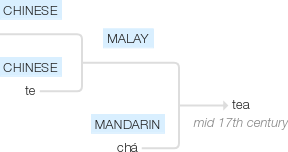Tea
mid 17th century: probably via Malay from Chinese (Min dialect) te ; related to Mandarin chá . Compare with char3.
wiktionary
Circa 1650, from Dutch thee, from Min Nan 茶(tê) (Amoy dialect), from Old Chinese, ultimately from Proto-Sino-Tibetan *s-la(“leaf, tea”).
Introduced to English and other Western European languages by the Dutch East India Company, who sourced their tea in Amoy; compare Malay teh along the same trade route. Doublet of chai and cha (and, distantly, lahpet), from same Proto-Sino-Tibetan root; see discussion of cognates.
From Chinese 茶(“tea”).
etymonline
tea (n.)
1650s, tay, also in early spellings thea, tey, tee and at first pronounced so as to rhyme with obey; the modern pronunciation predominates from mid-18c. But earlier in English as chaa (1590s), also cha, tcha, chia, cia. The two forms of the word reflect two paths of transmission: chaa is from Portuguese cha, attested in Portuguese from 1550s, via Macao, from Mandarin (Chinese) ch'a (cf chai). The later form, which became Modern English tea, is via Dutch, from Malay teh and directly from Chinese (Amoy dialect) t'e, which corresponds to Mandarin ch'a.
The distribution of the different forms of the word in Europe reflects the spread of use of the beverage. The modern English form, along with French thé, Spanish te, German Tee, etc., derive via Dutch thee from the Amoy form, reflecting the role of the Dutch as the chief importers of the leaves (through the Dutch East India Company, from 1610). Meanwhile, Russian chai, Persian cha, Greek tsai, Arabic shay, and Turkish çay all came overland from the Mandarin form.
First known in Paris 1635, the practice of drinking tea was first introduced to England 1644. Meaning "afternoon meal at which tea is served" is from 1738. Slang meaning "marijuana" (which sometimes was brewed in hot water) is attested from 1935, felt as obsolete by late 1960s. Tea ball is from 1895.
